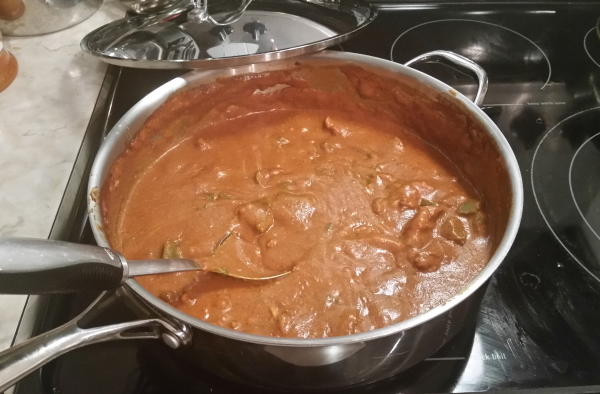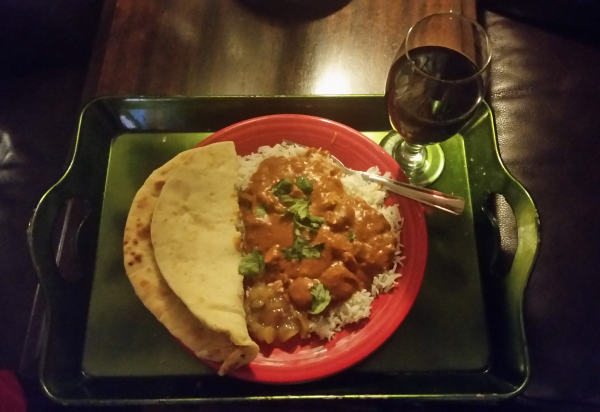The Chicken Tikka Masala Quest

My love affair with Indian food started twenty years ago when one of my girlfriends introduced me to the cuisine at a restaurant in Chapel Hill, North Carolina. My friend recommended starting out with a mild chicken tikka masala. From the first bite, I was hooked. Through the years, I have tried all sorts of dishes, including kormas, vindaloos, and dosas. From delicate coconut curry fish dishes to the hottest gobi manchurian, I have traveled the range of Indian dishes from north to south and everywhere in between. My heat tolerance moved from mild to Indian hot, an accomplishment of which I am very proud. The tikka masala sauce continues to be my favorite, and I typically order paneer tikka masala as my go-to favorite.
You would probably not expect it, but Lexington, Kentucky happens to be blessed with nearly ten Indian restaurants. Several of them are quite good, and I have spent many happy moments dining in restaurants and retrieving carry out. When I moved outside of Lexington, I mourned losing the easy access to Indian food. Though I can (and frequently do) drive thirty-five minutes to pick up carry out or eat in a restaurant, I miss having Indian food at my fingertips, so I started on my quest to make Indian food in my own kitchen.
Every few months, I try a different chicken tikka masala recipe, hoping to find the one that most closely resembles the sauce I have eaten in so many restaurants. Tikka masala falls into the British Indian food category. According to legend, the dish came to be when an Indian chef in Britain needed to make a gravy for chicken tikka (which is a dry chicken dish). The sauce consisted of a tomato-based curry in cream sauce, and some stories say the chef used Campbell’s condensed tomato soup. That could be a marketing ploy, or maybe it’s true.
Most recipes taste too bright to me and don’t taste like the restaurant versions at all. By bright, I mean that the flavors are not deep enough. They don’t convey the warmth and lasting heat I expect from a tikka masala sauce. I attribute the brightness to too much yogurt, ginger, and lemon. I might be totally wrong on that score, but that is my theory. The other day I found a reddit thread where a poster provided some insight into how chicken tikka masala is made in Indian restaurants. Here’s the thread: https://m.reddit.com/r/IndianFood/comments/2kr4x3/tikka_masala_restaurant_style/. The big differences I see between what the poster described and how most recipes read is that you make two sauces (an onion/garlic/ginger gravy and a tomato-based sauce) and the onion mixture needs to sweat for at least an hour rather than undergo a quick saute. Both sauces need to be blended to make them smooth. They also need to be cooled to room temperature and then heated up again.
One dining experience sticks in my mind. I ordered paneer tikka masala Indian hot. The server brought out the mildest version of the dish I have ever had. In fact, it reminded me of tomato soup. My husband and I both wondered if that was one of the keys. Most recipes call for a combination of diced tomatoes, tomato paste, and/or tomato sauce. The result is usually incredibly acidic regardless of the amount of spices and cream added. The reddit thread mentioned using ketchup in the sauce. To make things simple I tried Campbell’s condensed tomato soup in my latest attempt.
The result of my latest chicken tikka masala challenge is close to restaurant quality but still different. I think I have an idea of what needs to happen next time, including additional cream, more chopped cilantro in the sauce itself, and fenugreek. In fact, fenugreek seems to be missing from most recipes although it is an essential Indian cuisine ingredient according to Serious Eats and other resources.
I thought I would share my latest creation. The process takes time, so I recommend giving it a whirl on a weekend afternoon. Once I get the recipe the way I want, I plan to make batches of the sauces and freeze them for later use. I tried to document measurements where I could though I did rough it on the ground pepper, cream, and cilantro.
Chicken Tikka Masala
Part One: Onion Gravy
1 large yellow onion
1 small yellow onion
⅛ cup chopped ginger
⅛ cup chopped garlic (I used the minced garlic in a jar)
1 tsp cumin
Vegetable oil
Rough chop the onion and toss into a sauce pan with vegetable oil (enough to cover the bottom and lightly coat the onions). Bring the onion to a sizzle on medium high and drop to simmer. Cover and allow the onion to sweat 45 minutes. Add ginger, garlic, and cumin and sweat an additional 15 minutes. Note: I think all ingredients could sweat together for a full hour, and I will try that next time. Remove from heat and run mixture through food processor or blender until smooth. Pour the mixture into a bowl and allow it to cool at room temperature.
Part Two: Tomato Base
1 family-size Campbell’s Condensed Tomato Soup can (23.2 oz.)
1 regular-size Campbell’s Condensed Tomato Soup can (10.75 oz.)
1 tsp onion salt
1 tsp turmeric
1 tsp red pepper flakes
1 tsp garlic powder
Ground pepper
Note: I used two different sizes of Campbell’s soup for fear of not having enough tomato base. Campbell’s does make an organic version of the condensed soup, and I’m sure other companies make similar products. I decided to go old-school and use the original version this time. You can take a more traditional path with diced tomatoes, tomato paste, and/or tomato sauce. From what I read in the Reddit thread, it is better to use sauces and pastes over actual diced tomatoes due to the water content.
Pour the cans of soup into a large skillet (that has a lid). Add onion salt, turmeric, red pepper flakes, garlic powder, and ground pepper. I just eye-balled the ground pepper. Bring to a boil and stir frequently for a few minutes. Reduce heat to simmer and cover with lid. Let it simmer for an hour or so, stirring occasionally. Then turn it off, remove from heat, and let it cool.
Part Three: Chicken Marinade
Harvestland chicken breast tenderloins
1 cup plain yogurt
1 tablespoon lemon juice
1 tablespoon garam masala
1 tsp sea salt
Note: I forgot to check the number of ounces on the Harvestland chicken breast tenderloins package, but there were 8 in the pack. You can use breasts or thighs, and it doesn’t have to be Harvestland. The recipe probably could have handled more chicken than I used, but I was on a sauce quest more than anything. Also, garam masala recipes vary widely. I used Frontier Garam Masala (Organic).
Cut the chicken into bite-size pieces. Coat the chicken in the garam masala and sea salt (you can use more sea salt than what I did). Combine the lemon juice and plain yogurt (I used a Greek-style yogurt), and coat the chicken pieces in the mixture. Chill the chicken in marinade in your refrigerator for at least 45 minutes but no more than 5 hours. I let the chicken marinade while the sauces cooled down.
Part Four: Final Preparation
1 chopped green pepper
Vegetable oil
2 tbsp Kerrygold butter
Heavy cream
Cilantro
Saute the chicken with one chopped green pepper and vegetable oil until cooked halfway. Heat up both the onion gravy and tomato base in separate pans to a boil.
Add chicken and green pepper to tomato base. Add onion gravy to tomato base. Bring to a boil and reduce heat. Simmer for a half hour.
Add 2 tablespoons of butter (I prefer Kerrygold). Make sure butter is fully melted into the sauce. Add heavy cream slowly and stir. You can use as much as you like. Add chopped cilantro to sauce. Again, use as much as you like.
Pour chicken tikka masala over basmati rice and serve with chopped cilantro on top.
 I ate the chicken tikka masala with store-bought naan and mango chutney, and of course, I had a glass of wine, and yes, I ate in front of my television. Don’t judge! 🙂
I ate the chicken tikka masala with store-bought naan and mango chutney, and of course, I had a glass of wine, and yes, I ate in front of my television. Don’t judge! 🙂This recipe is a work in progress. My next iteration will include fenugreek, more cilantro, and more cream. As I try new avenues, I will update the recipe and share it. If you have tips/suggestions, please feel free to add them in the comments.

Oh, love this Recipe. I try this in my house and get the best taste. Please add more recipes, I already bookmark your site for future